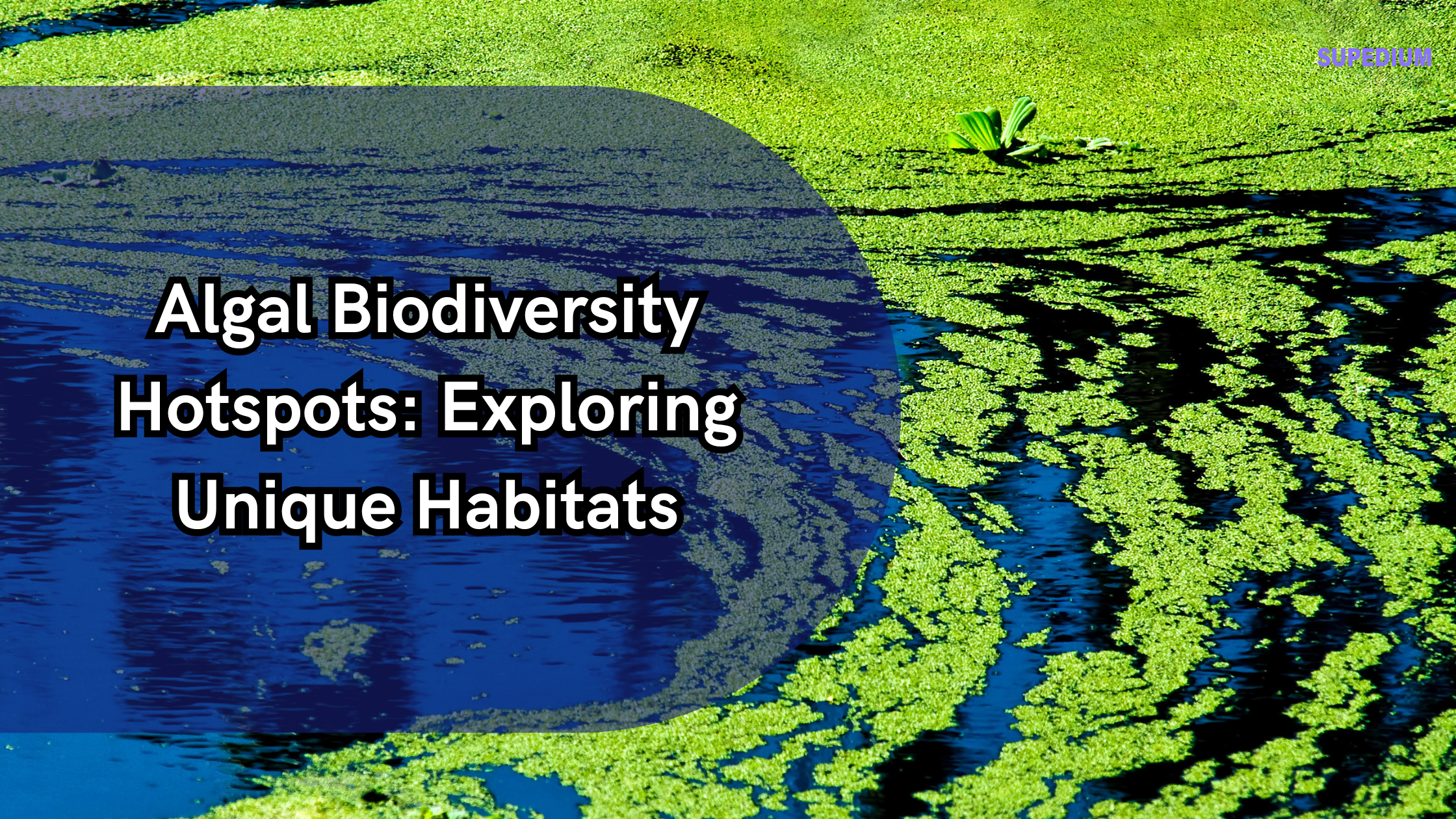Table of Contents
![]()
Introduction
Algae are critical components of aquatic ecosystems, contributing to primary production, habitat formation, and ecological balance. Among the various habitats where algae thrive, some regions stand out due to their exceptional levels of algal biodiversity. These areas, known as algal biodiversity hotspots, are characterized by a high richness of algal species and unique environmental conditions that foster their growth. Exploring these hotspots is essential for understanding ecological dynamics, assessing conservation needs, and leveraging potential biotechnological applications.
Overview of Algal Diversity
Algae are diverse organisms classified into two main categories: microalgae and macroalgae. Microalgae include phytoplankton and cyanobacteria, which are crucial for primary production in aquatic environments. Macroalgae, such as seaweeds and kelps, are larger and play significant roles in forming underwater habitats.
Algae contribute to ecosystems in several key ways:
- Primary Production and Food Webs: Algae form the base of aquatic food webs, converting sunlight into energy that sustains a wide range of marine and freshwater organisms.
- Habitat Formation: Macroalgae create complex habitats like kelp forests and coral reefs, which support diverse marine life.
- Biochemical and Ecological Interactions: Algae engage in various interactions, including competition and symbiosis, which influence their ecological roles and adaptability.
Characteristics of Algal Biodiversity Hotspots
Algal biodiversity hotspots are distinguished by several features:
- High Species Richness and Endemism: These areas support a diverse array of algal species, some of which may be unique to the region.
- Unique Environmental Conditions: Hotspots often have specific physical conditions (e.g., temperature, salinity) and chemical factors (e.g., nutrient levels, pH) that are conducive to the growth of diverse algal species.
- Ecological Processes and Interactions: The unique environmental conditions lead to complex ecological processes, including competitive and symbiotic relationships, and specialized adaptations.
Notable Algal Biodiversity Hotspots
- Coral Reefs
- Great Barrier Reef (Australia): This UNESCO World Heritage site is renowned for its diverse marine life, including a vast array of algal species that contribute to the reef’s health and productivity.
- Caribbean Coral Reefs: These reefs are home to numerous algae species that play crucial roles in maintaining reef structure and function.
- Coral Triangle (Southeast Asia): The Coral Triangle, encompassing parts of Indonesia, Malaysia, and the Philippines, is known for its high marine biodiversity, including a rich variety of algae.
- Kelp Forests
- Giant Kelp Forests (California Coast): Giant kelp (Macrocystis pyrifera) forms dense underwater forests that support diverse marine life along the California coast.
- South African Kelp Forests: These forests are notable for their unique species composition and ecological interactions.
- Patagonian Kelp Forests (Southern South America): These kelp forests are characterized by their rich biodiversity and important ecological functions.
- Mangrove Swamps
- Sundarbans (India/Bangladesh): This mangrove region supports a range of algal species adapted to brackish and saline conditions.
- Everglades (USA): The Everglades’ mangrove systems are home to diverse algae that contribute to the region’s ecological balance.
- Arctic and Antarctic Regions
- Polar Sea Ice Algae: In polar regions, algae living in and under sea ice play crucial roles in primary production during the short summer season.
- Antarctic Peninsula Coastal Areas: Coastal areas around the Antarctic Peninsula support unique algal communities adapted to extreme cold and light conditions.
- Freshwater Lakes and Rivers
- Lake Baikal (Russia): This ancient lake is home to unique algal species and has a high degree of endemism.
- Great Lakes (North America): The Great Lakes support diverse algal communities in both open water and nearshore environments.
- African Rift Lakes (e.g., Lake Tanganyika): These lakes are known for their ancient origins and high biodiversity, including numerous algal species.
Threats to Algal Biodiversity Hotspots
Algal biodiversity hotspots face several threats that impact their health and sustainability:
- Climate Change: Rising temperatures and changing weather patterns affect algal distributions and productivity. Ocean acidification, a result of increased CO2 levels, can also disrupt algal growth and community structures.
- Pollution: Nutrient runoff from agriculture and industry can lead to eutrophication, causing algal blooms that disrupt ecosystems. Chemical contaminants, such as heavy metals and plastics, pose additional threats to algal health.
- Habitat Destruction: Coastal development, overfishing, and destructive fishing practices can damage or destroy algal habitats, leading to loss of biodiversity.
- Invasive Species: Non-native algae can outcompete native species, altering ecosystem dynamics and reducing local biodiversity. For example, the invasive seaweed Caulerpa taxifolia has caused significant ecological changes in various regions.
Conservation and Management Strategies
Effective conservation and management strategies are crucial for preserving algal biodiversity hotspots:
- Marine Protected Areas (MPAs): Establishing MPAs can help protect critical habitats and reduce human impacts. Successful MPAs, such as the No-Take Zones in the Great Barrier Reef, demonstrate the benefits of effective protection.
- Restoration Projects: Techniques for restoring algal habitats include replanting kelp forests and cleaning up polluted areas. Restoration efforts, such as the restoration of eelgrass meadows, highlight both successes and challenges.
- Research and Monitoring: Ongoing research and monitoring are essential for understanding algal biodiversity and ecosystem health. Citizen science projects and public involvement can enhance data collection and raise awareness.
- Policy and Advocacy: International agreements, such as the Convention on Biological Diversity, and national and local policies play vital roles in protecting algal biodiversity. Advocacy efforts can help drive policy changes and promote conservation actions.
Future Directions and Research Opportunities
The future of algal biodiversity research involves several promising areas:
- Advances in Algal Biology and Taxonomy: Continued research on algal species and their classifications can provide new insights into biodiversity and evolutionary processes.
- Biotechnological Applications: Algae have potential applications in biofuels, pharmaceuticals, and other industries. Exploring these applications can lead to sustainable solutions and economic benefits.
- Climate Change Adaptation Strategies: Developing strategies to help algae adapt to changing climates will be crucial for maintaining biodiversity and ecosystem services.
- Integrating Traditional Knowledge with Scientific Research: Combining traditional ecological knowledge with scientific research can enhance conservation efforts and promote sustainable management practices.
Conclusion
Algal biodiversity hotspots are vital to understanding and preserving aquatic ecosystems. These regions, characterized by their rich algal diversity and unique environmental conditions, play crucial roles in maintaining ecological balance and supporting marine and freshwater life. Addressing the threats they face through effective conservation strategies and continued research is essential for ensuring their long-term sustainability. As we explore and protect these unique habitats, we can gain valuable insights and contribute to the broader goals of environmental stewardship and biodiversity conservation.
Share This





Be the first to comment